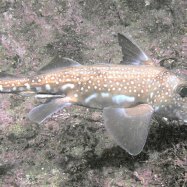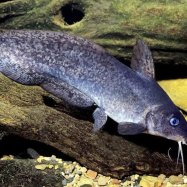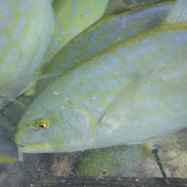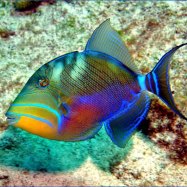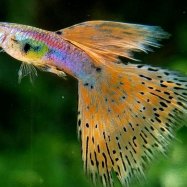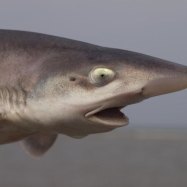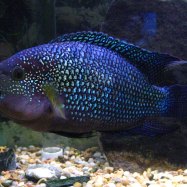
Sablefish
Adult sablefish do not undertake extensive migrations, but they may move to different depths based on temperature and prey availability.
Sablefish, also known as black cod, can live up to 90 years and are native to Alaska, British Columbia, and California waters. Adult sablefish may change their depth based on temperature and prey, but don't undergo extensive migrations. During breeding, male sablefish are known for their territorial behavior as they compete for female attention. #Sablefish #BlackCod #Alaska #BC #California
Summary of Fish Details:
Common Name: Sablefish
Habitat: Sablefish can be found in the North Pacific Ocean, specifically along the continental shelves of Alaska, British Columbia, and California. They are often found near rocky areas, submarine canyons, and seamounts.
Color: Sablefish are dark in color, ranging from dark gray to black.
Sablefish: The Mysterious and Delicious Deep-Sea Delicacy
Deep in the dark, cold waters of the North Pacific Ocean lies a mysterious and delicious fish called the sablefish. With its dark color, unique body shape, and impressive longevity, this creature has captured the fascination of fishermen and foodies alike.Scientifically known as Anoplopoma fimbria, the sablefish is commonly referred to as "butterfish" or "black cod" due to its melt-in-your-mouth texture and rich flavor. However, unlike other cod species, sablefish is not a true cod and has its own unique place in the ocean ecosystem Sablefish.
But what makes the sablefish so special? In this article, we will dive deeper into the world of this enigmatic fish, exploring its habitat, feeding habits, reproduction, and more.
A Habitat in the Depths of the North Pacific Ocean
The sablefish is primarily found in the North Pacific Ocean, specifically along the continental shelves of Alaska, British Columbia, and California. These fish prefer relatively deep waters of around 1,300 to 9,800 feet (400 to 3,000 meters), where temperatures are cooler and food is plentiful.They are known to frequent rocky areas, submarine canyons, and seamounts, often hiding among boulders and crevices on the ocean floor. Due to their elusive nature, little is known about their habitat and behavior in the wild, making them even more mysterious.
A Benthic Feeder with a Varied Diet
Sablefish are benthic feeders, which means they primarily feed on organisms found on or near the ocean floor. Their diet is varied and includes fish, squid, crustaceans, and other invertebrates. They are opportunistic predators, meaning they will feed on whatever prey is available in their habitat.Interestingly, sablefish have been observed feeding on jellyfish, which is an uncommon behavior for most fish Sunfish. This diet flexibility allows them to thrive in different habitats and helps them maintain their population in the ever-changing ocean environment.
The Dark and Slender Creature with a Big Appetite
At first glance, the sablefish may not seem like a remarkable creature. It has a long and slender body, with a large head and a prominent jaw. Its dark color, ranging from dark gray to black, helps it blend into its deep-sea environment, making it harder for predators to spot.But don't let its appearance fool you – the sablefish has quite a hearty appetite. It can grow up to 3.3 feet (1 meter) in length and can weigh as much as 40 pounds (18 kilograms). And with its varied diet, it's no wonder they have a big appetite.
The Secret to Its Longevity
One of the most intriguing facts about the sablefish is its impressive lifespan. These fish can live up to 90 years, making them one of the longest-living fish species in the world.The key to their longevity lies in their slow growth rate and low metabolic rate. These factors allow them to conserve energy and adapt to their deep-sea habitat. Unlike other fish species, sablefish do not reach sexual maturity until they are 10 to 20 years old. This late maturity rate also contributes to their long lifespan.
A Mysterious Reproduction Process
Sablefish are broadcast spawners, which means they release their eggs and sperm into the water column. Fertilization occurs externally, and once the eggs are fertilized, they drift with the ocean currents until they hatch.This reproductive process is still a mystery to scientists, and little is known about their spawning behavior in the wild. However, researchers have discovered that sablefish have high reproductive potential, with an average of 2.5 million eggs per female.
Spawning Competitions and Territorial Behavior
During spawning season, male sablefish exhibit territorial behavior and compete for access to females. They are known to engage in mouth-to-mouth and tail pushing battles to establish their dominance and claim a female.Researchers have also observed that male sablefish change color during spawning season – turning a brighter silver that contrasts their usual dark color. This color change is believed to be a way for males to attract females and display their fitness as potential mates.
A Calm Migration Pattern
Unlike other fish species, adult sablefish do not undertake extensive migrations. Instead, they may move to different depths based on temperature and prey availability. This calm migration pattern allows them to conserve energy and adapt to their surroundings, showcasing their resilience as a species.The Culinary Delight of the Deep
Aside from their mysterious nature, sablefish is also highly sought after for its delicious and flaky meat. Its high-fat content gives it a rich and buttery flavor, earning it the nickname "butterfish." Its delicate texture also makes it a versatile ingredient, perfect for grilling, smoking, and even sushi.Sablefish is a prized catch for commercial and recreational fishermen, with Alaska being the largest producer of sablefish in the world. Due to its popularity, efforts have been made to sustainably manage the sablefish population to ensure its availability for generations to come.
In Conclusion
The sablefish may be a mysterious creature, but one thing is for sure – it holds a special place in the depths of the North Pacific Ocean. Its adaptation to its deep-sea habitat, impressive longevity, and delicious meat make it a fascinating fish worth learning about and protecting. So whether you're a fisherman, foodie, or just curious about the wonders of the ocean, keep your eye out for the elusive sablefish on your next adventure.

Sablefish
Fish Details Sablefish - Scientific Name: Anoplopoma fimbria
- Category: Fish S
- Scientific Name: Anoplopoma fimbria
- Common Name: Sablefish
- Habitat: Sablefish can be found in the North Pacific Ocean, specifically along the continental shelves of Alaska, British Columbia, and California. They are often found near rocky areas, submarine canyons, and seamounts.
- Feeding Habitat: Sablefish are benthic feeders, which means they primarily feed on organisms found on or near the ocean floor.
- Feeding Method: They have a varied diet that includes fish, squid, crustaceans, and other invertebrates. They are opportunistic predators, feeding on whatever prey is available in their habitat.
- Geographic Distribution: Sablefish are distributed along the continental shelves of the North Pacific Ocean, including the waters of Alaska, British Columbia, and California.
- Country Of Origin: Sablefish are native to the waters of Alaska, British Columbia, and California.
- Color: Sablefish are dark in color, ranging from dark gray to black.
- Body Shape: They have a long and slender body with a large head and a prominent jaw.
- Length: Sablefish can grow up to 3.3 feet (1 meter) in length.
- Adult Size: Adult sablefish usually range from 2 to 3.3 feet (60 to 100 cm) in length.
- Age: Sablefish can live up to 90 years.
- Reproduction: Sablefish are broadcast spawners, which means they release their eggs and sperm into the water column. Fertilization occurs externally.
- Reproduction Behavior: During spawning, male sablefish exhibit territorial behavior and compete for access to females.
- Migration Pattern: Adult sablefish do not undertake extensive migrations, but they may move to different depths based on temperature and prey availability.

Sablefish
- Social Group: Sablefish are generally solitary fish, but they may form small groups during spawning.
- Behavior: Sablefish are primarily nocturnal, meaning they are more active at night. They are also known to be relatively sedentary.
- Diet: The diet of sablefish consists of fish, squid, crustaceans, and other invertebrates.
- Predators: Sablefish have few natural predators, but they may be preyed upon by larger fish, marine mammals, and seabirds.
- Prey: Sablefish primarily feed on fish, squid, crustaceans, and other invertebrates.
- Environmental Threats: Sablefish populations are threatened by overfishing, habitat destruction, and climate change.
- Conservation Status: Sablefish are not currently listed as an endangered species, but certain populations may be at risk due to overfishing.
- Special Features: Sablefish have an oily flesh that gives them a rich and buttery flavor. They are highly valued in the culinary industry.
- Interesting Facts: Sablefish have a high fat content, which allows them to survive in cold ocean temperatures. They are also known for their longevity, with some individuals living up to 90 years.
- Reproduction Period: Sablefish spawn once a year, usually during the winter months.
- Nesting Habit: Sablefish do not build nests. They release their eggs into the water column, where they are fertilized by the male.
- Lifespan: Sablefish can live up to 90 years.
- Habitat Threats: Sablefish populations are threatened by habitat destruction, pollution, and climate change.
- Population Trends: Population trends of sablefish vary depending on the specific region and fishing pressure. Some populations have declined due to overfishing, while others are relatively stable.
- Habitats Affected: Sablefish have a wide habitat range, but their populations can be affected by changes in ocean temperature, pollution, and habitat destruction.

Anoplopoma fimbria
The Fascinating World of Sablefish: Nature's Solitary Gourmet Fish
Under the dark and mysterious depths of the ocean lies a creature that has captured the attention of the culinary world – the sablefish. With its distinctive dark skin, oily flesh, and a remarkably long lifespan, the sablefish, also known as black cod, is a fascinating and highly valued species.Found in the cold and deep waters of the North Pacific Ocean, from Alaska to California, sablefish are solitary creatures that have adapted to survive in harsh, deep-sea environments. In this article, we will dive into the unique characteristics of the sablefish, from its social behavior to its special features and environmental threats RadioDouRosul.com.
Social Group and Behavior
One of the distinctive features of the sablefish is its solitary nature. Sablefish usually inhabit the ocean bottom in depths ranging from 300 to 2,000 meters, making it difficult for them to form large social groups. However, during the spawning season, which occurs once a year, sablefish may form small groups as they seek out potential mates.Apart from their social group tendencies, sablefish are primarily nocturnal, meaning they are most active at night. This behavior is thought to be an adaptation to avoid predators and to take advantage of the cover of darkness to hunt prey.
Sablefish are also known to be relatively sedentary fish, meaning they do not migrate or move around much. They prefer to stay in one area, using the contours of the ocean floor to their advantage, as they wait for prey to come within reach.
Diet and Prey
Sablefish are opportunistic predators, meaning they will eat whatever is available in their environment. Their diet primarily consists of fish, squid, crustaceans, and other invertebrates Sillago. This allows them to be versatile hunters, as they can adapt to changes in their environment and prey availability.Because they inhabit the ocean bottom, sablefish hunt for prey using their sensitive barbels, long and slender tactile organs, to detect vibrations and movements in the water. They also have large eyes, allowing them to see in the dark depths, giving them an edge when hunting at night.
Predators
Despite being solitary and relatively sedentary, sablefish have few natural predators. However, they may be preyed upon by larger fish, marine mammals, and seabirds. Orcas, also known as killer whales, are one of the main predators of sablefish. They have been observed using specialized hunting techniques to prey on sablefish, such as forcing them to the surface and creating waves to throw them off balance.Environmental Threats and Conservation Status
The biggest threat to sablefish populations is overfishing. Sablefish have been heavily targeted for commercial fishing, as they are highly valued in the culinary industry for their rich and buttery flavor. This has led to significant declines in some sablefish populations, making them vulnerable to extinction.In addition to overfishing, sablefish populations are also threatened by habitat destruction and climate change. These fish are sensitive to changes in ocean temperature and pollution, which can impact their survival and reproductive success.
Currently, sablefish are not listed as an endangered species. However, certain populations may be at risk due to overfishing and other environmental threats. The International Union for Conservation of Nature (IUCN) has classified sablefish as a species of “least concern,” but their conservation status may change in the future if proper management and conservation efforts are not implemented.
Special Features and Interesting Facts
One of the most unique features of sablefish is their oily flesh. This characteristic gives them a rich and buttery taste, making them a highly sought-after delicacy in the culinary world. Their high-fat content not only gives them their distinct flavor but also allows them to survive in the cold ocean temperatures.Another interesting fact about sablefish is their remarkably long lifespan. It is estimated that sablefish can live up to 90 years, making them one of the longest-living fish species. This impressive longevity may be due to their slow growth rate and low metabolic rate, which allows them to conserve energy and survive in the cold, dark depths of the ocean.
Reproduction and Nesting Habits
Sablefish reach sexual maturity at around five to seven years of age. They spawn once a year, usually during the winter months, making it a slow and steady process to replenish their populations. Unlike other fish species, sablefish do not build nests. Instead, the female releases her eggs into the water column, where they are fertilized by the male.After fertilization, the eggs develop into larvae, which spend several months drifting in the ocean before settling to the ocean bottom, where they will grow and mature.
Habitat Threats and Population Trends
Sablefish have a wide range of habitats, from the deep and cold ocean waters to the shallower, warmer coastal areas. However, their populations can be affected by changes in ocean temperature, pollution, and habitat destruction.The population trends of sablefish vary depending on the specific region and fishing pressure. Some populations have declined due to overfishing, while others are relatively stable. In recent years, there has been a growing concern over the sustainability of sablefish fisheries, leading to stricter management and conservation measures.
In conclusion
The sablefish is a unique and fascinating species that has captured the attention of both scientists and food enthusiasts. With their solitary nature, special features, and impressive longevity, they continue to thrive in the depths of the ocean. However, as with many other marine species, their survival is threatened by human activities. It is essential to understand and protect these creatures to ensure their existence for generations to come. Let us all do our part in preserving the world’s diverse and beautiful marine species, like the solitary gourmet of the ocean – the sablefish.

Sablefish: The Mysterious and Delicious Deep-Sea Delicacy
Disclaimer: The content provided is for informational purposes only. We cannot guarantee the accuracy of the information on this page 100%. All information provided here may change without prior notice.


